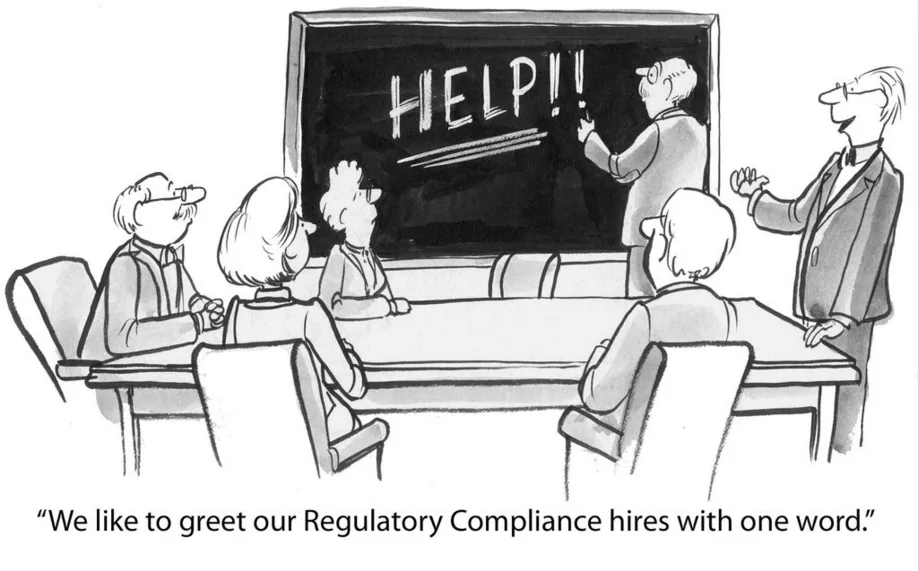The Importance of Regulatory Training and How to Ensure it Isn’t a Flop

Understanding Regulated Industries
A regulated industry is one that’s restricted and regulated by the government or other agencies, whether that be federal or state. There can be guidelines in place dictating how everything from production to profits are handled in regulatory industries.

Some of the generalized industries where there’s a significant amount of regulation include finance, healthcare, and medical device manufacturing, to name a few.
In the healthcare industry, some of the regulation is based on HIPPA standards or the Health Insurance Portability and Accountability Act of 1996. The Food and Drug Administration (FDA) regulates the pharmaceutical and medical device manufacturing industries, while the Federal Deposit Insurance Corporation (FDIC) regulates the banking industry. The banking and financial industries, in particular, are facing an onslaught of new regulations and compliance standards nearly daily, particularly in the wake of the Great Recession.
The SEC implemented the Sarbanes-Oxley Act, which requires that CEOs and CFOs of all publicly traded U.S. companies demonstrate their financial dealings are fair and adequately documented. To adhere to these standards, stringent internal controls are required.
OSHA, which stands for the Occupational Safety and Health Administration, mandates a set of standards covering issues regarding environmental health and safety. These standards are designed to keep workplaces and employees safe, particularly in manufacturing environments.
The Importance of Regulatory Training
If regulated organizations don’t properly train employees, it can be incredibly problematic. Take a 30-day free trial of eLeaP and get regulatory training under control.
If employees don’t adhere to regulatory standards, the government and associated agencies can fine companies. These fines can be so large companies end up closing their doors as a result.
There can also be legal issues associated with a lack of regulatory training. For example, if a fracking company fails to follow regulations set forth by the EPA, it can mean serious legal repercussions and, depending on the situation, even jail time for some within a business.
In the healthcare industry, failure to provide adequate and effective regulatory and compliance training can mean the loss of life or dangerous situations, such as the spreading of disease.
Even if an organization isn’t subjected to fines or legal consequences, a lack of regulatory training can seriously impact a company’s public brand and image.
The Challenges of Regulatory and Compliance Training

The number one challenge of regulatory training is that it’s boring, to put it simply.
Employees dislike this type of training because it tends to be dry, dull, and long. Employers can often feed off this energy and find it burdensome to administer regulatory training to employees since it’s frequently met with resistance. Even when employees do participate in regulatory training, it’s difficult to get information to stick since they tend to be disengaged from the content.
Compliance and regulatory training tend to be rooted in facts, and it’s all about transferring knowledge, but the focus isn’t often on actually changing the behavior of employees.
Another challenge of regulations? They’re constantly being changed, updated, and added to, which means it’s difficult to keep training up-to-date. Training that’s even a few months old can be outdated depending on your industry and how much regulation it’s subjected to.
Even if adequate regulation training is provided, if it’s given in a traditional classroom setting, there may not be satisfactory tracking and reporting available. Without tracking and reporting, companies can find themselves in trouble when it’s time to prove they’re training employees.
Regulation training tends to be a “knee-jerk” reaction to a prompt or stimulus—usually, a negative situation that happens in a business. This conditions employees to see it as a punishment rather than a necessary and vital part of the business. Instead of waiting to use regulatory training to address a problem after it arises, it should be proactively administered.
Finally, organizations often approach compliance training in a standardized way. It’s delivered to all employees in the same way, at the same time, without regard for their individual differences or their varying roles within an organization.
Using e-Learning As a Solution to Regulatory Training Challenges
The use of a learning management system addresses all of the regulatory training challenges listed above and then some.
The first thing businesses should look to when designing regulation training is creating the concept that it’s an inherent part of day-to-day life within an organization. For an organization to be fully compliant, it needs to have a culture that integrates these ideas into every aspect of the workplace. This starts at the top and then moves downward within an organization. Regulatory and compliance training shouldn’t be one-offs that are done only when it’s absolutely required. They should become part of the workplace in a consistent and systematic way.
e-Learning allows you to not only design an organizational framework where regulation is at the center of all activities, but you can also make changes, updates, and additions as you go. Classroom training simply isn’t a realistic option for compliance training because regulations are constantly evolving. It would be financially and realistically impossible to update classroom training as much as regulations are updated. In most cases, with the use of a learning management system, you can always make quick and easy updates, changes, or complete overhauls to regulatory training without investing a great deal of time or money into the process. See how eLeaP makes this process seamless and easy.
With the use of an LMS, you can appeal to a variety of learning styles, including auditory and visual learners, so you’re customizing the training experience without spending a huge amount of time or money.
E-learning is also an ideal compliance training solution because it can be used on demand. If an employee forgets a key point from a training module, it’s easy to use a tablet or smartphone to refer back to necessary information at the moment and on the job.
Finally, use as many interactive elements as you can in this type of employee training to ensure it’s engaging and actionable. Regulatory training, because of its dry subject matter, can be the perfect place to incorporate videos, scenarios, role-playing, and gamification.
What have you found to work in terms of training your employees on necessary regulations and governmental guidelines?